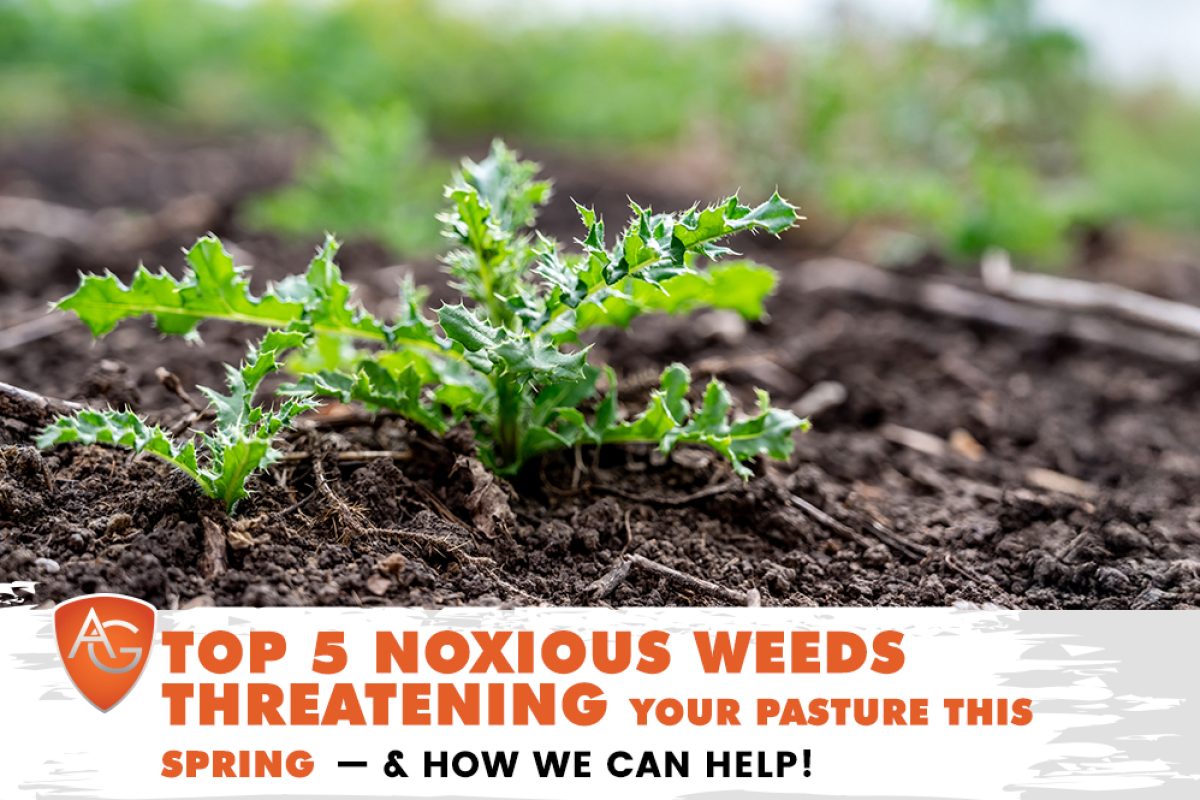Overview: Noxious weeds like Larkspur and Dalmatian Toadflax are threatening pastures across Laramie County and Wyoming this spring. Learn the top 5 to watch for — and how All Around Ag can help you reclaim your fields. Read on!
Spring is a critical time for pasture health across Laramie County, Cheyenne, and Wyoming. As grass begin to grow, so do the weeds — and not all of them are just an eyesore. Some species can crowd out valuable forage, reduce livestock performance, and set you back for the entire grazing season.
Below are 5 noxious weeds making a strong appearance this spring. Whether you manage cattle, horses, or hay ground, keeping an eye out early can make all the difference!
1. Larkspur
Often found in foothill and mountain pastures, Larkspur is known for its toxic effects on cattle. Its alkaloids can cause sudden death, especially when consumed in the early growth stages before other forage becomes available. Cattle tend to graze less selectively in spring, making this weed especially dangerous.
Where to look: South-facing slopes, elevations above 6,000 feet, or areas with recent soil disturbance.
>> Related Reading: Why Larkspur is Dangerous for Cattle & How to Manage It
2. Dalmatian Toadflax
Dalmatian Toadflax looks like a snapdragon, but it’s no garden flower. This perennial spreads by both seeds and creeping roots, forming dense stands that outcompete native grass and reduce overall pasture productivity.
Common locations: Roadsides, dry rangeland, and sandy soils in areas like Wellington and north into Wyoming.
3. Canada Thistle
Fast-growing and hard to control, Canada Thistle spreads by underground rhizomes and can take over quickly if left unmanaged. It competes for moisture and space, leaving less room for beneficial grass.
Spot it: Clumps of spiny, lance-shaped leaves and purple flower heads in mid to late spring. It’s common in overgrazed pastures and near water sources.
4. Houndstongue
With its broad leaves and burr-like seeds, Houndstongue isn’t just invasive — it’s also toxic to livestock. It often invades disturbed soils and overgrazed pastures and can latch onto cattle, wildlife, and clothing.
Be aware of: Seed spreads in early spring and again in late summer. It’s often found along trails, fence lines, and creek bottoms.
5. Leafy Spurge
This one’s tricky — it’s aggressive and can look deceptively pretty with its bright yellow bracts. Its deep roots make it especially difficult to remove, and cattle tend to avoid it, giving it even more room to grow.
Our recommendation: Spring is the best time for suppression. We help landowners develop a multi-year treatment plan, including chemical applications and pasture recovery strategies.
A Strong Start Makes a Difference
Spring is the best time to scout your pasture and take note of what’s popping up. Early detection means fewer long-term impacts on forage quality, grazing rotation, and hay yields. Managing these weeds is never a one-and-done job — it takes season-long awareness and a working knowledge of what’s normal (and what’s not) on your land.
We don’t just sell hay — we partner with local ranchers and farmers to protect and improve forage production across Laramie County and Wyoming. Whether it’s a one-time noxious weed treatment or a long-term pasture management plan, we’re here with practical, affordable solutions that reflect your operation’s values.
Call us today to schedule your spring weed inspection and treatment plan. Let’s get your pasture back on track — before the weeds take hold.
